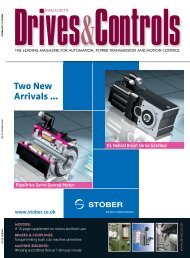New Danfoss VLT® Decentral Drive E cient, reliable and powerful
New Danfoss VLT® Decentral Drive E cient, reliable and powerful
New Danfoss VLT® Decentral Drive E cient, reliable and powerful
You also want an ePaper? Increase the reach of your titles
YUMPU automatically turns print PDFs into web optimized ePapers that Google loves.
Sponsored column<br />
No. 3 November/December 2010<br />
DESIGN DATA<br />
Dave’s DIARY<br />
DRIVES<br />
In this regular feature, Dave Baston, UK General Manager<br />
for Control Techniques, looks at how modern drive <strong>and</strong><br />
motor technologies can improve your business. In this issue,<br />
Dave insists that a proposed rating system for variable speed<br />
drives (VSDs) must take a system-level view<br />
For as long as I can remember, I’ve advocated the use of variable<br />
speed drives (VSDs) to raise motor efficiency. They cost more upfront,<br />
but ongoing energy savings will dwarf the initial investment.<br />
Their benefits in pump <strong>and</strong> fan drives are already well known, <strong>and</strong><br />
the EC Energy Using Products (or Ecodesign) Directive has identified<br />
VSDs as a desirable technology. The biggest potential for energy<br />
being applications that move air or fluids at an adjustable rate, i.e.<br />
fans <strong>and</strong> pumps.<br />
An obvious next step is to introduce an efficiency grading scheme<br />
for VSDs, as is already done for electric motors. The EC has issued a<br />
m<strong>and</strong>ate to CENELEC to develop a suitable technical st<strong>and</strong>ard.<br />
Developing it will be a technical challenge, because it’s difficult to get<br />
an accurate measure of VSD efficiency: mostly because it’s already so<br />
high (97-98%), measuring the ratio between input <strong>and</strong> output power<br />
stretches current instrumentation to the limit. And that’s before we’ve<br />
addressed more general questions: which operating conditions should<br />
be covered? And how should results be weighted?<br />
The key problem is that the quality of the drives output waveform<br />
significantly impacts on the losses within the motor. The loss in a<br />
VSD is 2-3% of rated throughput. The loss in the motor is 5-20%,<br />
depending on the rating. A simple drive only efficiency rating would<br />
be meaningless because it would ignore these system-level effects.<br />
Any new st<strong>and</strong>ard for VSD efficiency must address this dilemma –<br />
perhaps by defining an efficiency test between power source <strong>and</strong><br />
shaft, using a hypothetical ‘st<strong>and</strong>ard motor’. I can already hear the<br />
arguments, but they’re worth overcoming if we’re to avoid a<br />
simplistic st<strong>and</strong>ard for VSDs that ignores their effect on the motor.<br />
Jargon Buster - The Ecodesign Directive<br />
The Ecodesign Directive (http://ec.europa.eu/enterprise/policies/<br />
sustainable-business/documents/eco-design/framework-directive/<br />
index_en.htm) provides consistent EU-wide rules for improving the<br />
environmental performance of energy related products (ERPs) through<br />
ecodesign - a way of thinking about design which takes into account the<br />
environmental impact of a product or packaging across its entire<br />
existence, including Raw Materials, Manufacture, Retail, Use & End of<br />
Life. This approach is known as life cycle thinking <strong>and</strong> can be used to<br />
reduce environmental impacts as well as costs for businesses.<br />
Do you agree? Tell us what you think:<br />
Visit www.controltechniques.com/viewpoint<br />
Rockwell Automation has published a White Paper<br />
explaining how intelligent motor control centres<br />
(MCCs) – which integrate communications,<br />
hardware <strong>and</strong> software – can help to minimise<br />
downtime. The eight-page publication outlines the<br />
evolution of MCCs, configuration methods,<br />
networking advantages, <strong>and</strong> real-world<br />
application examples. It describes the underlying technologies,<br />
including advanced monitoring <strong>and</strong> sensing devices, <strong>and</strong> network<br />
connections. Intelligent MCCs can cost less to install than<br />
traditional MCCs <strong>and</strong> offer protective, monitoring <strong>and</strong><br />
troubleshooting advantages. They also allow manufacturers to<br />
capture <strong>and</strong> use equipment <strong>and</strong> process data to improve<br />
productivity.<br />
http://goo.gl/prgn<br />
US-based Abhisam Software has announced the publication of a<br />
downloadable eBook called The Quick Guide to AC Variable<br />
Frequency <strong>Drive</strong>s, which explains how drives work, <strong>and</strong> how to<br />
select, use <strong>and</strong> install them in common applications. The<br />
“vendor-neutral” guide contains six chapters covering all aspects<br />
of VSDs from basic concepts related to AC induction motors <strong>and</strong><br />
their control, to an explanation of functions such as vector<br />
control, torque control, anti-windmill control, <strong>and</strong> dynamic<br />
braking. The eBook is available at an introductory price of $27,<br />
<strong>and</strong> a free trial can be downloaded from Abhisam’s Web site.<br />
www.abhisam.com<br />
PI (Physik Instrumente) has published a 400-page<br />
catalogue covering its piezomechanical<br />
components <strong>and</strong> motion systems, from simple,<br />
direct actuators, to long-travel ceramic linear<br />
motors <strong>and</strong> complex multi-axis flexure guided<br />
nanopositioning stages. A separate section lists<br />
control electronics. The catalogue includes a<br />
tutorial on piezo design for positioning applications. It can be<br />
downloaded as a PDF.<br />
www.piezo.ws/pdf/Piezo_Mechanism_Cat10.pdf<br />
Thomson has produced a guide to using electric<br />
linear actuators to replace hydraulic <strong>and</strong><br />
pneumatic cylinders in off-road machinery <strong>and</strong><br />
vehicles. Potential applications include controlling<br />
engine speed, operating safety locks remotely,<br />
lifting access panels, <strong>and</strong> controlling spool valves.<br />
The publication compares electric actuators with<br />
fluid power drives <strong>and</strong> outlines their advantages<br />
including low development costs, easy installation, user-friendly<br />
control functions, low energy costs, high adjustment accuracy,<br />
low maintenance, <strong>and</strong> environmental acceptability. The brochure<br />
is available as a downloadable PDF.<br />
http://goo.gl/JJquQ<br />
Leuze electronic has issued a 12-page brochure<br />
describing its machine safety inspection service,<br />
as well as its machine safety devices <strong>and</strong> support<br />
services. It explains the company’s UK-based<br />
technical support service, its 24-hour telephone<br />
helpline, its parts return process, its machine<br />
stop-time measurement service, <strong>and</strong> its machine<br />
safety training. The publication also covers the free-to-download<br />
ePlan macros for Leuze’s machine safety components<br />
01480 408 500 mail@leuze.co.uk<br />
http://bit.ly/LeuzeMachineSafetyInspections<br />
48 November/December 2010 www.drives.co.uk




